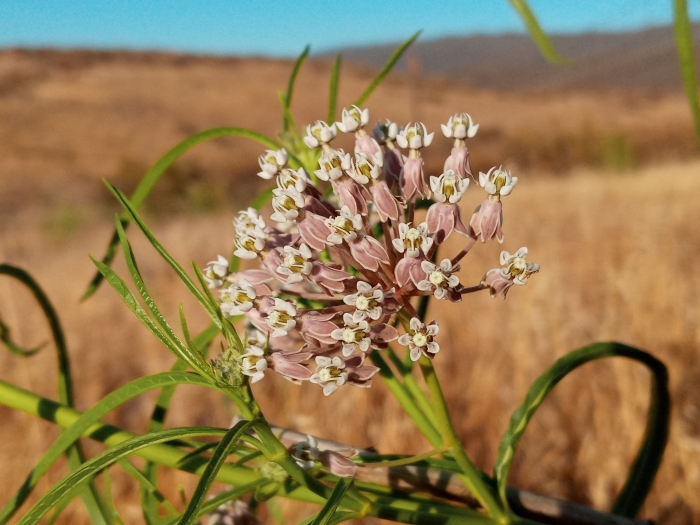Narrowleaf Milkweed
(Asclepias fascicularis)
Narrowleaf Milkweed (Asclepias fascicularis)
/
/

Daniel S.
CC BY 4.0
Image By:
Daniel S.
Recorded By:
Copyright:
CC BY 4.0
Copyright Notice:
Photo by: Daniel S. | License Type: CC BY 4.0 | License URL: http://creativecommons.org/licenses/by/4.0/ | Rights Holder: Daniel S. | Publisher: iNaturalist | Date Created: 2021-06-09T18:49-07:00 |




























































Estimated Native Range
Summary
Asclepias fascicularis, commonly known as Narrowleaf Milkweed or Mexican Whorled Milkweed, is a perennial herb native to grasslands, chaparral, open woodlands, and desert scrub in the Western and Intermountain regions of the USA, as well as parts of Mexico. It typically grows to a height of 1-3 feet and a width of 0.5-1 feet. The plant is characterized by its slender, erect stems and narrow leaves, which give rise to its common names. It produces clusters of intricate flowers ranging in color from lavender to pale pink, purple, white, and occasionally greenish hues. These blossoms are highly attractive to pollinators and bloom from late spring to late summer, offering a long season of visual interest. The fruit pods are typical of milkweeds, smooth and elongated, splitting open to release seeds attached to silky hairs that facilitate wind dispersal.
Narrowleaf Milkweed is valued for its role in supporting butterfly populations, particularly as a host plant for the Monarch butterfly larvae. It is a popular choice for butterfly gardens, wildlife habitats, and in native plant, drought-tolerant, and natural landscaping projects. This milkweed thrives in full sun and is adaptable to various soil types, although it prefers well-drained soils. It is drought-tolerant once established, requiring low to medium amounts of water. While generally low-maintenance, it can be susceptible to aphids and milkweed bugs. Gardeners should be aware that all parts of the plant contain toxic compounds that can be harmful if ingested.CC BY-SA 4.0
Narrowleaf Milkweed is valued for its role in supporting butterfly populations, particularly as a host plant for the Monarch butterfly larvae. It is a popular choice for butterfly gardens, wildlife habitats, and in native plant, drought-tolerant, and natural landscaping projects. This milkweed thrives in full sun and is adaptable to various soil types, although it prefers well-drained soils. It is drought-tolerant once established, requiring low to medium amounts of water. While generally low-maintenance, it can be susceptible to aphids and milkweed bugs. Gardeners should be aware that all parts of the plant contain toxic compounds that can be harmful if ingested.CC BY-SA 4.0
Plant Description
- Plant Type: Herb
- Height: 1-3 feet
- Width: 0.5-1 feet
- Growth Rate: Moderate
- Flower Color: Pink, White
- Flowering Season: Summer, Fall
- Leaf Retention: Deciduous
Growth Requirements
- Sun: Full Sun
- Water: Low, Medium
- Drainage: Slow
Common Uses
Bank Stabilization, Bee Garden, Bird Garden, Border Plant, Butterfly Garden, Deer Resistant, Drought Tolerant, Fragrant, Hummingbird Garden, Low Maintenance, Showy Flowers, Street Planting
Natural Habitat
Native to grasslands, chaparral, open woodlands, and desert scrub in the Western and Intermountain regions of the USA, and parts of Mexico
Other Names
Common Names: Narrow-Leaved Milkweed , Mexican Whorled Milkweed
Scientific Names: Asclepias fascicularis , Asclepias mexicana , Asclepias fasciculata , Asclepias macrophylla , Asclepias macrophylla var. comosa , Asclepias verticillata var. mexicana
GBIF Accepted Name: Asclepias fascicularis Decne.